Tag archives: LHC
CMS publishes 700 papers, extreme data centres, flat-Earth space programme launches tomorrow

Big data: analysis of CMS papers. See Rao’s article for an interactive version (Courtesy: Achintya Rao/CMS)
By Hamish Johnston
CERN’s CMS collaboration has passed a milestone of sorts at the end of October – it published its 700th research paper. And physicists working on the giant detector on the Large Hadron Collider haven’t stopped there as the tally is now 712 and rising.
CERN’s Achintya Rao has delved into the CMS archives and has chosen his top seven papers. These include the first-ever paper about the detector, which was published in 2008 and, embarrassingly, gets the weight of the detector wrong. Rao has also put together an interactive infographic that looks at 680 papers that analyse data collected by CMS.
View all posts by this author | View this author's profile
John Ellis on physics after the Higgs boson, calculating the loudness of the Big Bang, the chemistry of ironing
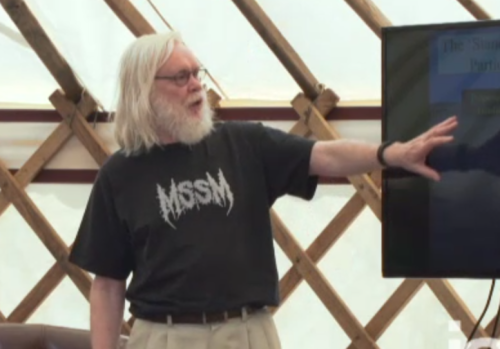
Looking ahead: John Ellis on the future of particle physics. (Courtesy: IAI TV)
By Hamish Johnston
In 2012 particle physicists gave themselves a giant pat on the back when the Higgs boson was discovered at the Large Hadron Collider at CERN – nearly 50 years after it was first predicted to exist. But what have particle physicists done since, and what does the future hold for the field? In a video called “After the Higgs boson: what’s next for 21st century physics?” from the Institute of Art and Ideas, the theoretical physicist John Ellis charts the future course of particle physics. Pay attention for a joke about the UK’s foreign secretary Boris Johnson.
View all posts by this author | View this author's profile
Great wagers in physics, CERN’s pine marten gets stuffed, Doomsday Clock moves closer to midnight
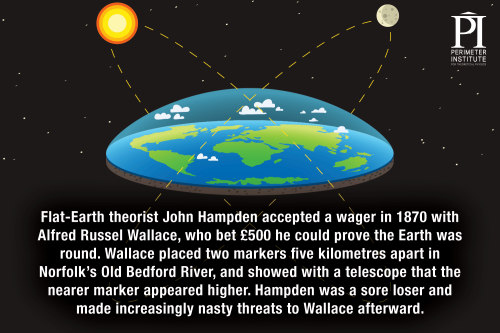
Flat out: Wallace saw him coming. (Courtesy: PI)
By Hamish Johnston
I bet you can’t resist clicking on “Great wagers in physics history” – which has been compiled by Colin Hunter at the Perimeter Institute for Theoretical Physics in Canada. A surprising number involve Stephen Hawking, whose record on winning is quite abysmal according to Hunter. Hawking’s fellow Cantabrigian Isaac Newton also enjoyed a flutter and accepted Christopher Wren’s offer of 40 shillings to anyone who could – in two months – derive a force law that explained Keplers laws of planetary motion. Newton succeeded, but ran overtime so he didn’t collect the cash. In the image above you can read about another wager involving a “flat-Earth theorist”.
View all posts by this author | View this author's profile
China eyes new high-energy collider
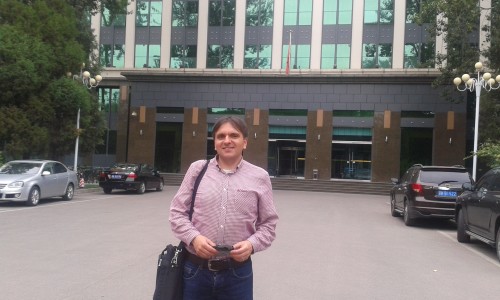
Matin Durrani outside the Institute of High Energy Physics in Beijing before interviewing Xinchou Lou.
By Matin Durrani in Beijing, China
I had just landed in Beijing this morning when I saw an e-mail from my colleague Mingfang Lu waiting for me on my phone. Mingfang, who’s editor-in-chief at the Beijing office of the Institute of Physics, which publishes Physics World, has been helping me to organize my itinerary for the next week as I gather material for our upcoming special report on physics in China. You may remember we published a Physics World special report on China in 2011 but so much has happened since then that we felt it’s easily time for another.
Mingfang’s e-mail was to say we would be off at 2.30 p.m. to interview Xinchou Lou, a particle physicist at the Institute of High Energy Physics, about the country’s ambitious plans for a “Higgs factory”. If built, this 240 GeV Circular Electron–Positron Collider (CEPC) would be a huge facility (50 km or possibly even 100 km in circumference) that will let physicists study the properties of the Higgs boson in detail. I say “if”, but knowing China’s frenetic progress in physics, it will almost certainly be a case of “when”.
View all posts by this author | View this author's profile
Fractals and infinite curves, sonified data and farewell to Sir Tom Kibble
By Tushna Commissariat
Fractals have always fascinated me and I am sure it’s the same for many of you. What I find most intriguing about them is how the relatively simple base pattern, or “seed”, quickly scales up to form the intricate designs we see in a snowflake or a coastline. In the video above, mathematician and animator Grant Sanderson has created a montage of “space filling curves” – theoretically speaking, such curves can endlessly expand without every crossing its own path to fill an infinite space. Following on from these curves, Sanderson shows you just how a simple seed pattern grows into a fractal and also describes how small changes to a seed property – such as an angle in a V – can alter the final image. The above video follows from a previous one Sanderson created on “Hilbert’s curve, and the usefulness of infinite results in a finite world” so check them both out.
View all posts by this author | View this author's profile
The May 2016 issue of Physics World is now out
 By Matin Durrani
By Matin Durrani
Physics stretches from the small to the large, from the simple to the complex and from low energy to high. It spans the entire alphabet too, with this month’s issue of Physics World including everything from the race to produce anti-atoms (A) at the CERN particle-physics lab near Geneva to a study of the physics of zombies (Z).
Zombies don’t exist, obviously. But we look at two physicists – Alex Alemi and Matt Bierbaum – who have studied the statistical physics of how zombies spread. As science writer Stephen Ornes explains, their interest emerged from a fun student project, but has led to a paper in a leading peer-reviewed journal and helped generate a wider appreciation of statistical physics.
If you’re a member of the Institute of Physics (IOP), you can now enjoy immediate access to the new issue with the digital edition of the magazine in your web browser or on any iOS or Android mobile device (just download the Physics World app from the App Store or Google Play). If you’re not yet in the IOP, you can join as an IOPimember for just £15, €20 or $25 a year to get full access to Physics World digital.
View all posts by this author | View this author's profile
Physics saves humanity, the large rainfall collider and other environmental highlights on Earth Day
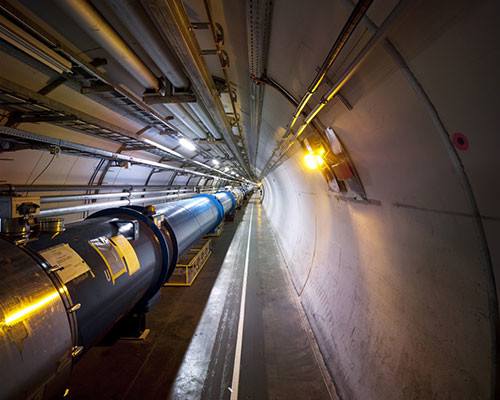
Gravity’s pull: could the LHC be used as a giant rain gauge? (Courtesy: CERN)
By James Dacey and Hamish Johnston
Today is Earth Day, so let’s temporarily rename this regular Red Folder column as the Green Folder. Either way, today we’re going to focus on the Earth and environmental issues. The official website of Earth Day – an initiative now in its 46th year – has details about the various initiatives and events taking place around the world today.
First, let’s pay tribute to a physicist whose work had a profound influence on the climate and energy debate in the UK and beyond. Sir David Mackay died on 14 April aged 48 following a battle with cancer. Mackay is remembered among other things for his pragmatic approach to energy and his 2008 book Sustainable Energy: Without the Hot Air (free access) was hailed for its rigour and refreshing absence of rhetoric. Mackay’s writings attracted the interest of the British government who appointed him as chief scientific adviser to the Department of Energy and Climate Change in 2009, a post he held for five years. Ever prolific, Mackay was blogging about his experiences right up until two days before his death.
‘New boson’ buzz intensifies at CERN, fire prevention in space and Neil Turok on a bright future for physics
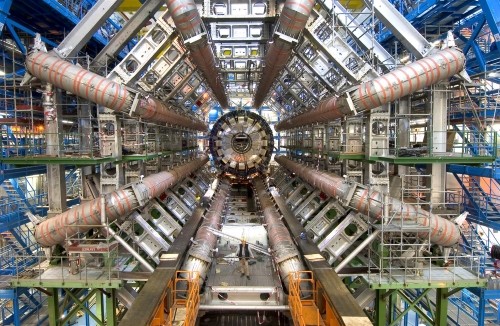
ATLAS under construction: has the experiment gone beyond the Standard Model? (Courtesy: ATLAS)
By Hamish Johnston
Excitement levels in the world of particle physics hit the roof this week as further evidence emerged that physicists working on the Large Hadron Collider (LHC) may have caught sight of a new particle that is not described by the Standard Model of particle physics. If this turns out to be true, it will be the most profound discovery in particle physics in decades and would surely lead to a Nobel prize.
View all posts by this author | View this author's profile
Santa and the space station, holiday gift suggestions and no Christmas presents for SUSY

Father Christmas will soon be on his way to the International Space Station. (Courtesy: NASA)
By Hamish Johnston
In this festive edition of the Red Folder, NASA has come up with a great way for youngsters to spot Santa’s sleigh as it streaks across the sky on Christmas Eve. It turns out that Santa hitches a ride with the International Space Station, so you can use NASA’s Spot the Station tool to find out when Father Christmas will be visible above your town. A search on Bristol, UK reveals that Santa will be overhead at 17:21 – perfect for getting the children to bed early.
Hoverboards had looked set to be the hot gift this Christmas, but now the news is full of horror stories about the two-wheeled contraptions bursting into flames. Blogger Sabine Hossenfelder has written a wonderful self-described “rant” about an article in Wired by the physicist Rhett Allain called “You can’t ride a hoverboard without Einstein’s theory of general relativity”. In the true spirit of a Christmas pantomime, Hossenfelder’s response is “Oh yes you can”.
Undeterred, Allain has just posted a new item on Wired that looks at the physics – or lack thereof – in this Christmas’s blockbuster film: “The physics in Star Wars isn’t always right and that’s ok”. I look forward to Hossenfelder’s riposte!
Maria Spiropulu talks about multiple Higgs beyond the Standard Model
By Hamish Johnston in Waterloo, Canada
Caltech’s Maria Spiropulu has a great party trick. She can demonstrate the bizarre rotational property of a spin ½ particle using a full glass of water and a contortion of her arm without spilling a drop. This was just one of the many highlights of her talk about the future of experimental particle physics that she gave yesterday at the Convergence meeting here at the Perimeter Institute.
While Spiropulu doesn’t talk about spin in the above video, she does explain why she is looking forward to analysing data from the 13 TeV run of the Large Hadron Collider, where she is part of the CMS collaboration. So, what could Spiropulu and colleagues find when they dig into the vast amounts of data that CMS is currently producing? It just could be four more types of Higgs particle. To find out more watch the video.
View all posts by this author | View this author's profile